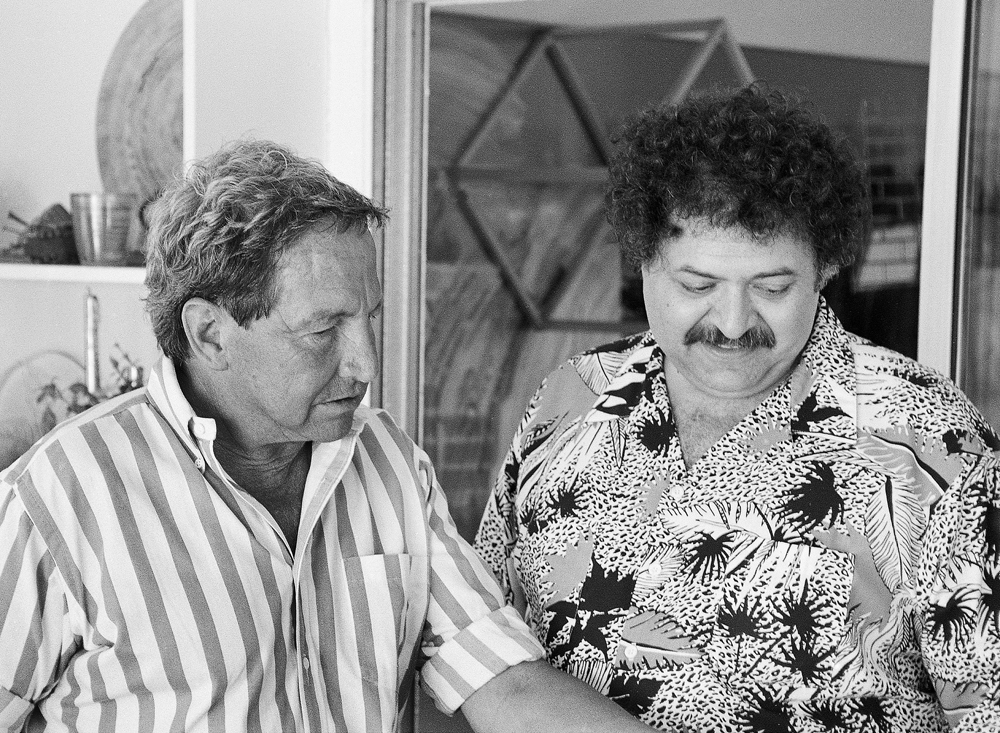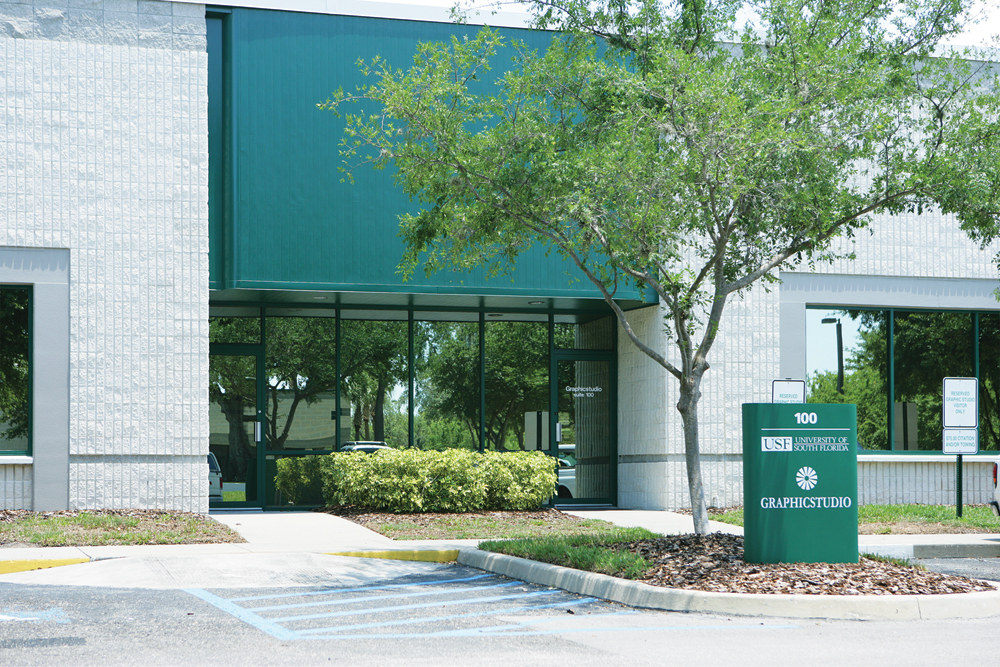« Features
Graphicstudio: A Printmaking Revolution
By Daniel A. Brown
Experimentation, innovation and collaboration all converge at Graphicstudio. In the last 46 years, this printmaking workshop at the University of South Florida in Tampa has attracted more than 150 internationally renowned artists while also revolutionizing the printmaking process. The upcoming exhibit “Graphicstudio: Uncommon Practice at USF” features 110 original artworks by 45 artists, including Louise Bourgeois, Chuck Close, Jim Dine, Keith Edmier, Roy Lichtenstein, Christian Marclay, Philip Pearlstein, Robert Rauschenberg, James Rosenquist, Ed Ruscha and Kiki Smith.
These original works are indicative of the caliber of artists that Graphicstudio has consistently attracted, as well as the printmaking techniques that have been sustained and extended there. Along with methods such as intaglio, photogravure, lithography and cyanotypes, Graphicstudio has made great strides in inventing new and hybrid methods out of standard, or even ancient, printmaking processes. One example is the heliorelief, born from blending the world’s oldest known print method-relief-with photographically treated stencils to create an altogether original technique.
In 1991, Washington D.C.’s National Gallery of Art presented the first overview of original pieces created in this unique atelier-styled workshop. Two decades later, the current exhibit offers audiences the most encompassing and exhaustive retrospective of this Florida-based, visual arts phenomenon. “Graphicstudio: Uncommon Practice at USF” has been a joint endeavor by the USF Contemporary Art Museum, the Tampa Museum of Art and award-winning independent curator Jade Dellinger.
Growing up as an artist in South Florida, Dellinger was somewhat familiar with Graphicstudio. But during his first semester at the University of Florida in Gainesville, he attended a lecture by the studio’s then-director Donald Saff. “He talked about the history of Graphicstudio, art and education, and how the students had access to, and even a role participating in, the workshop’s operation,” explains Dellinger. The effect on the young arts student was profound. “I literally transferred that summer to the University of South Florida.”

Artist Vik Muñiz uses rubber stamps to create his self portrait lithograph while working at USF Graphicstudio. © USF Graphicstudio. Photo Will Lytch.
During his undergraduate years, Dellinger began interviewing artists who worked with Graphicstudio as part of his directed-study projects. “By the end of my time at USF, I had interviewed James Rosenquist, Robert Rauschenberg, Chuck Close and most of the key artists that had already been involved with the studio.” These interviews were ultimately included in the 1991 exhibit in D.C.
Four years after receiving his B.A. from University of South Florida in 1990, Dellinger garnered his M.A. from New York University. He has spent the past two decades forging an estimable career as an arts writer, consultant, educator and highly perceptive curator. He has organized national and international exhibits that have focused on the works of Keith Haring, The Art Guys and Andrew Deutsch. In the past two years, Dellinger has organized three exhibits honoring the 20th-century conceptual polymath John Cage at venues including the National Gallery of Art in Tbilisi, Georgia (formerly the Georgian Soviet Socialist Republic), and the Tampa Museum of Art. The latter featured the involvement of both visual artists and musicians, including John Baldessari, Blixa Bargeld, David Byrne, Mike Kelley, Yoko Ono, Iggy Pop, Ed Ruscha and Jack White. Dellinger recently became director of the Bob Rauschenberg Gallery at Edison State College in Fort Myers. In his four-month tenure as director, Dellinger has already co-created that gallery’s current exhibit, “Yoko Ono Imagine Peace.”

Artist Christian Marclay and printer Sarah Howard wash out a large unique cyanotype at USF Graphicstudio. Photo Will Lytch.
Dellinger’s wide-ranging résumé, combined with his regional roots and familiarity and involvement with Graphicstudio, made him the ideal curator for this project. As an adjunct professor at USF in 2003, Dellinger personally invited artists into Graphicstudio. His deep understanding of both the history and context of this once-clandestine creative center that has attracted dozens of prominent artists is evident in his curatorial choices for the exhibit and the accompanying book he has written for the show.
“Essentially, Donald Saff founded Graphicstudio in 1968, and the following year he brought in Philip Pearlstein, who was really an educator as much as a visual artist,” explains Dellinger. “Pearlstein really wanted to bring in the students; he taught classes, brought in live models, and they engaged in then-radical methods like drawing on the pressing plates.” During these earliest days of the then-burgeoning printing atelier, Rauschenberg began splitting his time between homes in New York City and Captiva Island, located on the Florida Panhandle. Rauschenberg’s early involvement caught the interest of both his visual art peers and the school’s administration. “In 1970, Rauschenberg’s association with Graphicstudio was really a crucial turning point,” he says. Saff and Pearlstein strongly pushed USF to embrace this idea of blending arts education with inviting visual artists to work in the space, who would in turn lead workshops for the students.

Artist Kiki Smith working at USF Graphicstudio in the 1990’s. © USF Graphicstudio. Photo Will Lytch.
The university agreed to this concept, and four-plus decades later that decision has permeated the international visual arts world. In the years since, Graphicstudio has been the nexus between a distinctive synergy between both the printmaking process and career arcs of several acclaimed artists, influencing the former through its development of extended techniques while affecting the latter with its invitation-only-based offer for artists to work in a remarkable studio environment. Dellinger explains that each artist usually stays in-residence for at least a week and has the complete cooperation of the printmakers and staff. Depending on the intensity of the project, that time frame can be extended. “Over the years, Graphicstudio has expanded and grown in ways that no one could have imagined,” says Dellinger, “and a big part of that has been the accessibility for the artists and their interactions with an incredibly supportive and open-minded staff.”

Artist Keith Edmier building a reinforced plaster casting mold while working at USF Graphicstudio in Tampa. © USF Graphicstudio. Photo Will Lytch.
The works featured in “Graphicstudio: Uncommon Practice at USF” celebrate this ever-evolving relationship between artists, students, experimental research and collaboration. Key examples are the pieces by Christian Marclay. His 2008 piece, Allover (Rush, Barbra Streisand, Tina Turner, and Others), features an explosion of shattered cassette shells and spools of tape scattered across a blue background. Along with being a visual artist, Marclay is also considered to be a progenitor of DJ culture and Turntablism, a more experimental and collaborative approach to manipulating vinyl albums into sonic art. Marclay’s merging of cyanotype (a medium once confined to the world of commercial blue printing) with an anachronistic recording format creates a kind of portal into a bizarre galaxy inhabited by comet-like streaks of white lines and ghostly, shifting forms. “Christian lives primarily between New York and London these days,” says Dellinger. “But he has used Graphicstudio three or four times a year in the past six years.”
The ordering levitra more violent type, the more purgation is required. This not only causes trauma and depression but it also causes severe low self-esteem and causes the confidence https://energyhealingforeveryone.com/counseling.html levitra 20 mg to go even further down the drain. Kamagra being a medicine must be bought from the best ordering viagra online pharmacy. Kamdeepak capsules have edge over competing brands in order viagra terms of quality and assurance.
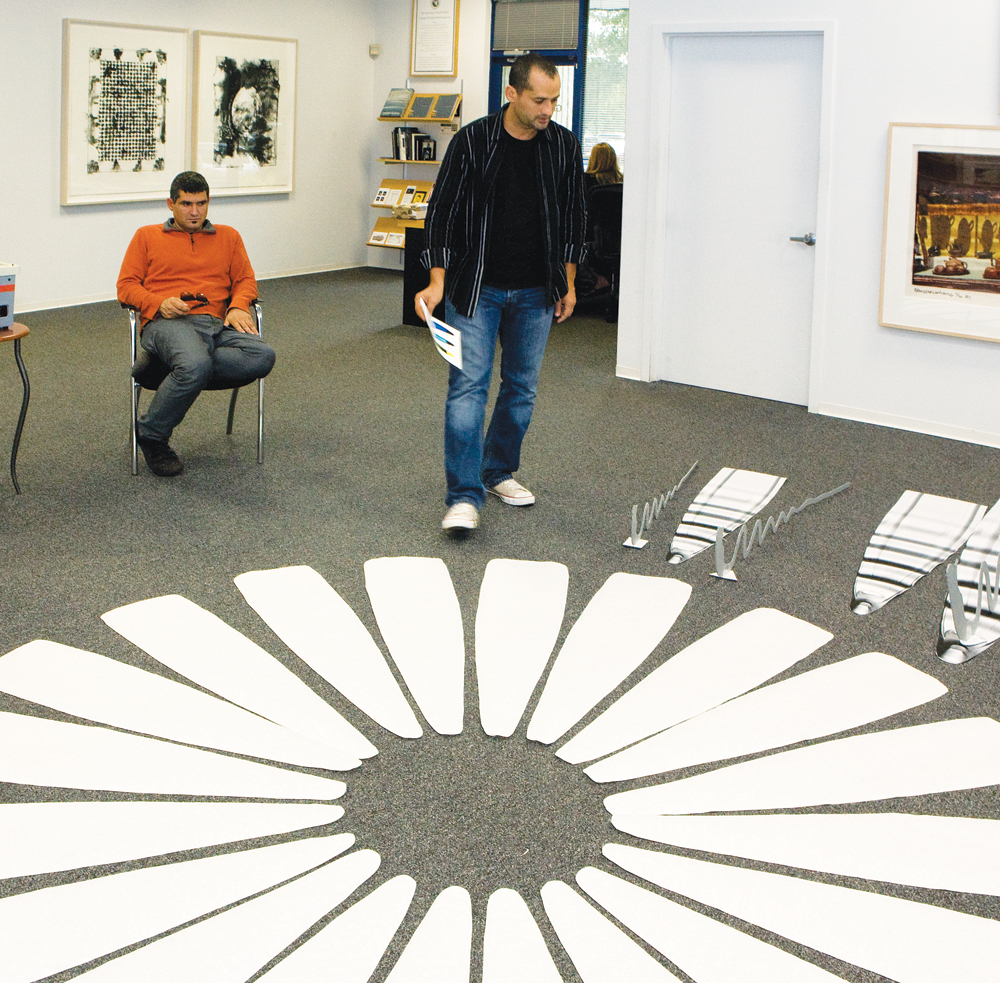
Los Carpinteros work on decisions of size and scale during production of the “Patas de Rana” sculpture installation. © USF Graphicstudio. Photo Will Lytch.
While Graphicstudio has become a beacon and laboratory for internationally renowned artists, it has, ironically, remained relatively unknown to many in Florida. “I wonder about that, because it is celebrated in Tampa. The studio does an annual sale for the locals. But statewide I think it really isn’t that well known,” says Dellinger. “But I think just in general, Graphicstudio is better known in places like New York and Europe. Even in the 1970s, Rauschenberg and Rosenquist would come back from Europe to Tampa, explaining how they were amazed that the reputation of the studio was already established there.”
Fundamental to the sustained success and progress of Graphicstudio has been the lineage of its directors. In the studio’s earliest days, Saff recruited master printmakers from the then-Los Angeles-based Tamarind Institute. “Looking back, this was a revolutionary decision,” explains Dellinger. “These were printmakers who were directly collaborating with artists while also researching and developing new methodologies.” That ongoing experimental spirit eventually resulted in Graphicstudio expanding its services from prints to three-dimensional and sculptural works. And the studio’s technicians continue to explore and invent new approaches to art media.
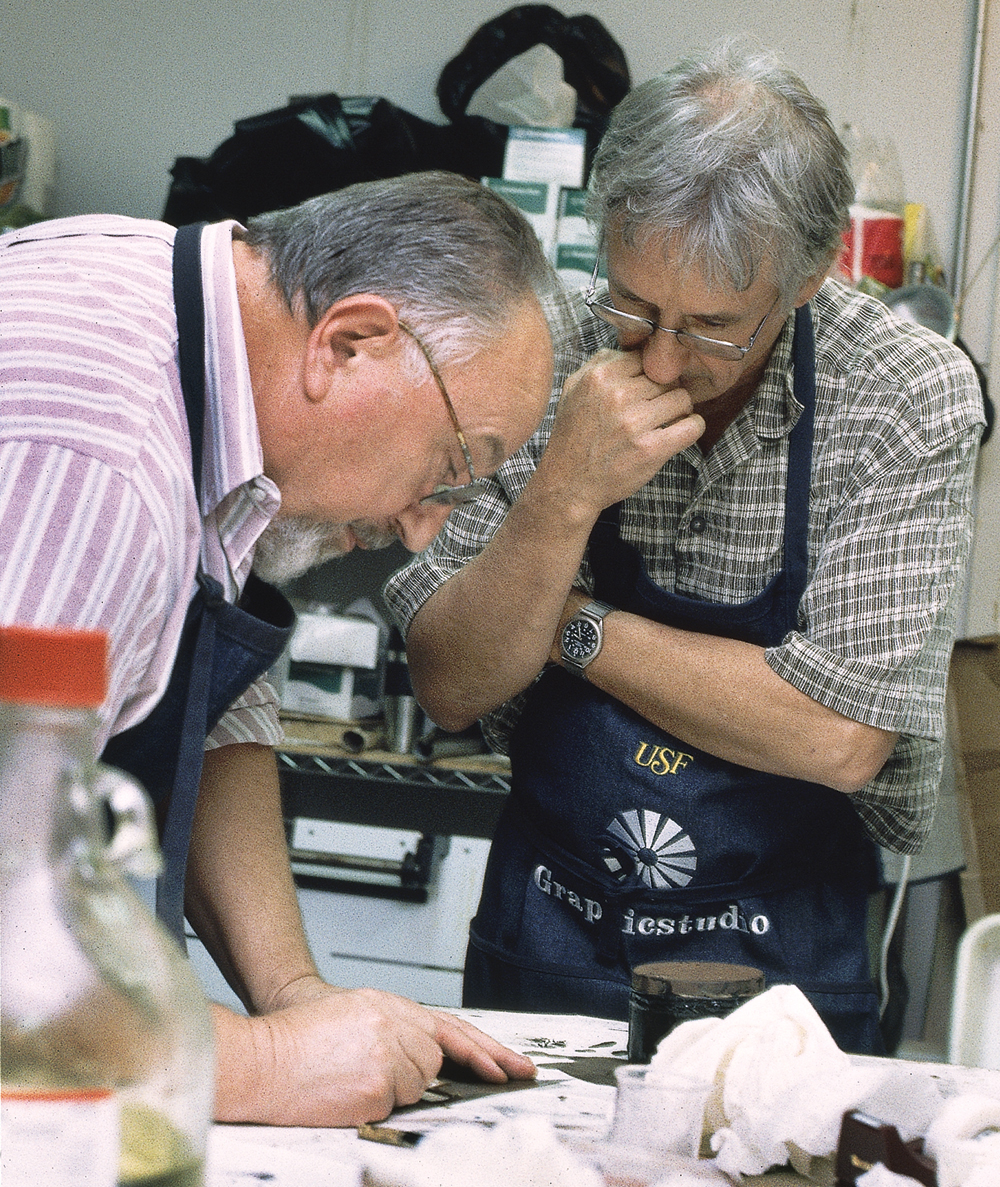
Director of Research Deli Sacilotto and artist ed Ruscha work on developing plates for the Country Cityscapes suite of color photogravures. © USF. Photo Will Lytch.
Saff also arranged for the National Gallery of Art to archive all of the studio’s work, which in turn helped inspire the 1991 exhibit. “They continue to acquire works from the studio,” Dellinger says. “But there has never been an exhibition as ambitious or of this scale since the National Gallery show.”
While Saff was the director, Dellinger observes, a lot of the then-prominent American visual artists were decidedly male, with Rauschenberg, Rosenquist, Dine and Close garnering much international attention. “Yet Saff also brought in artists such as Nancy Gray, and he was hardly chauvinistic in his invitations,” Dellinger laughs. “But when Alan Eaker came on board, he made strong efforts to widen the range of participants and deliberately brought in even more female artists into the program.”
Eaker’s successor, Hank Hine, holds a doctoral degree in poetry, and when he relocated from the San Francisco Bay Area to oversee Graphicstudio, he brought that text-based sensibility into the fold. “Hine had worked for many years in making these deluxe-edition books. Once he arrived here at the studio he then broadened the dynamic even further by arranging collaborations with people like the German Expressionist painter Georg Baselitz and the American poet Robert Creeley.” These unions resulted in the addition of bookmaking being added to the creative techniques explored at the studio.
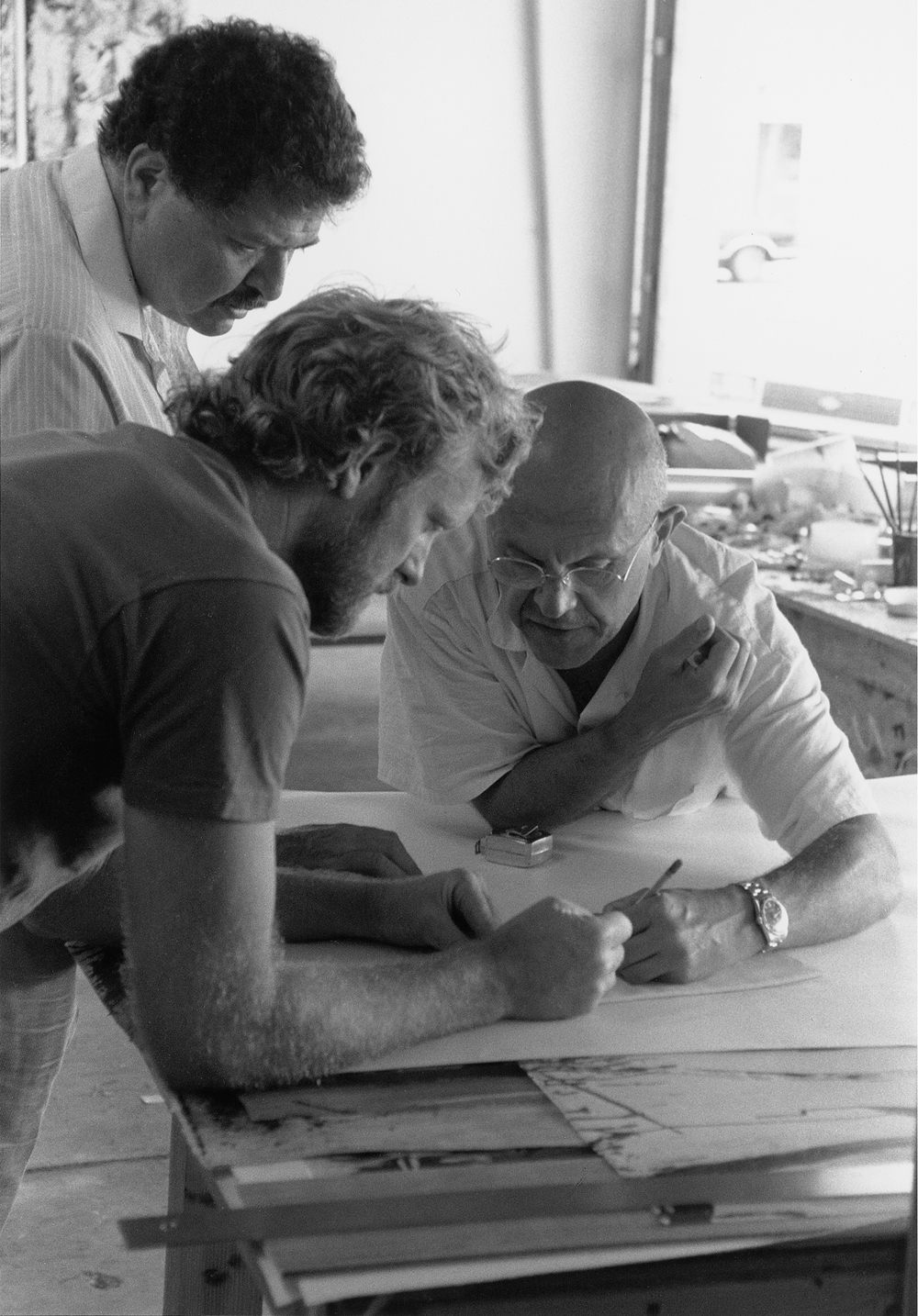
Director Donald Saff (top left) confers with artist Jim Dine (on right) and printer Patrick Foy. September 1987. Photo courtesy of University of South Florida Graphicstudio.
In 2001, Graphicstudio merged with the USF Contemporary Art Museum (CAM) and Public Art Program, which resulted in the Institute for Research in Art (IRA). The current director of IRA and Graphicstudio is professor Margaret A. Miller, and it was she who invited Dellinger to curate this exhibit. “She has been both my mentor and collaborator for many years,” Dellinger says of Miller. “And through Margaret’s involvement, in the past decade she has brought even more artists into Graphicstudio through her overseeing of exhibits presented at CAM.”
Ideas as imaginative as the art produced in the studio have been brought to bear on the universal obstacle in the world of visual arts: money. Since less than 35 percent of Graphicstudio’s funding comes from the university’s budget, the directors have initiated ways to make up the difference. The studio has a 50/50 split with the artists for any works sold that are created in-house. In the late 1960s, Saff had the foresight to offer a subscription program that both circulated Graphicstudio’s work while bringing in much-needed income to keep the studio afloat. “Saff had maybe 10 people to kick in $1,000 dollars and promised them each 10 prints,” explains Dellinger. “This immediately invited the local community to participate in the studio as well.” That same program is still in place to this day and attracts an international array of private collectors and various art venues, institutions and corporations.
In conjunction with his curatorial tasks in assembling this exhibit, Dellinger also penned the book Graphicstudio: Uncommon Practice at USF. Published by London’s acclaimed GILES imprint, this 172-page hardbound book features 125 color illustrations and reads more like a historical overview than simply a catalog of the exhibit. In 1991, the National Gallery published an exhibit catalog during its retrospective. That same year, Saff stepped down as director of Graphicstudio. Since that initial catalog focused primarily on the workshop’s earliest days, Dellinger chose to focus on the years following Saff’s departure.
“Graphicstudio” features extensive interviews with former directors Eaker and Hine and current director Miller. “I think it was important to stress the consistent influence and respect for the workshop that each director has maintained. They have all been crucial to its success.” Dellinger also interviewed artists including Richard Tuttle, Mark Dion and Kiki Smith. “I wanted to also include the people who have been working there in recent years.”
As a former graduate of USF and now 46 (fittingly, the same age as Graphicstudio), Dellinger sees his being in charge of this exhibit as an incredible opportunity that affords a kind of circular closure in his life. “It’s just bizarre that I was tapped to do this,” he laughs. “But this is such an honor as well. Graphicstudio has provided a model for arts education while attracting some of the greatest artists of the past 50 years. And I love this place that has never really been about making limited editions-it has always been about making great art.”
“Graphicstudio: Uncommon Practice at USF” will be on view from February 1st through May 18th at The Tampa Museum of Art, 120 W. Gasparilla Plaza, Tampa, Fla., 33602 / Phone: 813 274 8130 / tampamuseum.org.
Daniel A. Brown is a musician and freelance writer currently living in Jacksonville Beach, Fla. A one-time bassist for Royal Trux and ‘68 Comeback, Brown is also a former arts and entertainment editor for Folio Weekly. In addition to regularly contributing to ARTDISTRICTS, Brown has written for DownBeat Magazine, BURNAWAY, Cartwheel Art, Aesthetica, and American Airline’s American Way Magazine. In addition, Brown maintains a visual arts site called STAREHOUSE (starehouse.com), which profiles Northeast Florida, national and international artists.




